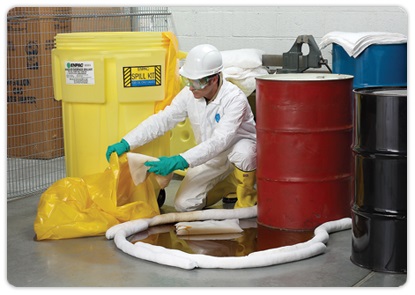OIL SPILL RESPONSE &
PREVENTION
FREE - Training Module on PERMIT TO WORK
All industry employees having a role in managing
or maintaining oil containing devices must be able to initiate an appropriate
oil spill response.
Basic guidelines on Oil Spill Response:
1.Assess the severity of the situation
Determine if the situation is immediately
hazardous to your well being, evacuate if in danger.
For large spills that can reach a drain or catch
basin, immediately call the spill response team.
If situation allows, quickly cover/block the
floor drain/catch basin with a drain cover, boom, speedy dry, etc.
Evacuate personnel from the immediate area of the
spill.
Identify the spilled material(s) ...
Barricade the spill area and notify others in surrounding
areas.
Extinguish or disconnect all sources of ignition
and contact the fire department
2.Contain Small Incidental Spills
Contain spill without endangering self or others.
Block storm drains and floor drains/openings to
prevent spilled material from reaching the environment
Ensure the area is properly ventilated
FREE - ISO 45001 AUDIT CHECKLIST : PART 2
3.Small Spill Clean Up
Wear the Proper Protective Equipment (safety
goggles, oil resistant gloves, etc)
Use absorbent materials to clean spill ( speedy
dry, etc)
4.Manage the Contaminated Waste Appropriately
Store contaminated materials/waste from the clean
up in appropriate covered buckets or drum with a secured lid
Affix a Hazardous Waste label on the container (except
cooking oil)
Follow all the local government regulations.
Oil Spill Prevention:
All waste oil containers need to be placed in/on
secondary containment that has a storage capacity of 110% of the container
size.
Perform monthly inspections on all oil containing
devices.
Know where all spill kits are located in your plant
and take time to ensure they are properly stocked.
Group discussion topics with the team:
Identify any past spill situations and how they
were handled.
Are there any oil containing devices that pose a
greater risk than others for a potential spill/release?
3 - WORK AT HEIGHT PRECAUTIONS -





I think some more information about means/resources for spill response locally such as spill kits and third party intervention would be a useful information to make this article better.
ReplyDeleteIs it Available for IMO Level 1,2 and 3 training and held by Online?.. Please advice..?..
ReplyDelete